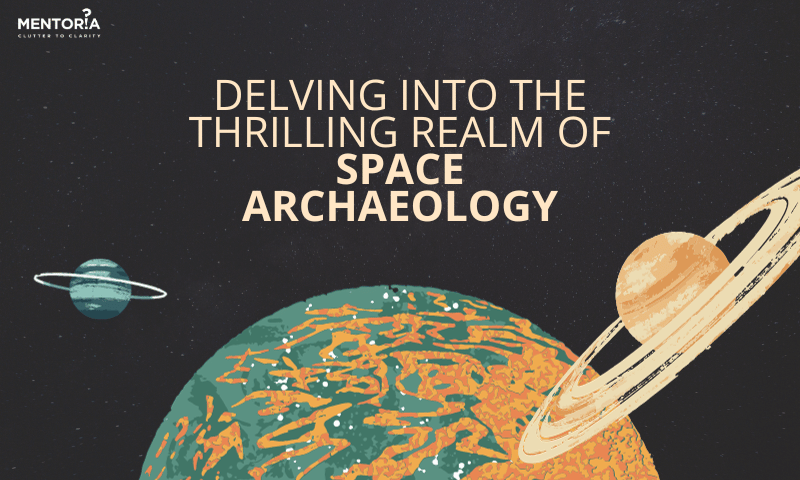Delving Into The Thrilling Realm Of Space Archaeology

Look up at the night sky, and you’ll see stars, planets, and endless wonders. But did you know that there’s more to space than meets the eye? It’s not just about astronauts and rockets; there’s a captivating field called space archaeology, and it’s like a cosmic treasure hunt. Imagine being an explorer like Indiana Jones, but instead of ancient temples and dusty maps, you’re delving into the mysteries of the universe itself. Space archaeology isn’t about digging up artefacts in the dirt; it’s about uncovering the secrets of our past in the vastness of outer space. In simple terms, it’s like connecting history and astronomy. Every discovery in space archaeology takes us closer to understanding where we come from in the grand story of the cosmos. So, get ready for an extraordinary journey where the past meets the stars, and every find is a piece of the cosmic puzzle. It’s a space adventure like no other!
What Is Space Archaeology?
Space archaeology is the study of human history beyond Earth. It’s like a time machine that allows us to uncover ancient mysteries by looking at objects in space. These objects could be old satellites, space junk, or even traces of human activity on other planets. Space archaeology is most popular in the United States, where space exploration has a rich history. NASA, the American space agency, has been a pioneer in this field. It is a relatively young field, emerging in the last few decades. It gained momentum as humans started leaving their mark in space with satellites and missions to other planets.
With the increasing clutter in space and plans for future space missions, the demand for space archaeologists is on the rise. They play a crucial role in preserving our space heritage and ensuring the safety of future missions. In essence, space archaeology is an exciting field that bridges the gap between history and space exploration. It’s a journey into the unknown, where each discovery unveils a new chapter in the epic tale of humanity’s adventures beyond our home planet.
Lunar Archaeology
Our celestial neighbour, the Moon, has long fascinated space archaeologists. Human missions like Apollo have left valuable archaeological sites on the lunar surface. The Apollo 11 landing site preserves footprints, equipment, and lunar modules—a testament to human exploration beyond Earth. Lunar archaeology offers a unique window into our own cosmic history and the future of space exploration.
Intriguingly, the lunar surface acts as a time capsule, preserving footprints and artefacts untouched for decades. Each artefact left behind by astronauts carries historical significance, serving as a testament to humanity’s first steps on another celestial body. Space archaeologists meticulously study these lunar sites to gain insights into early space exploration and the challenges faced by astronauts. As of 2023, six Apollo missions have successfully landed astronauts on the Moon, with 12 astronauts having walked on its surface.
The Impact Of Meteorites
Meteorites, celestial wanderers from the depths of space, carry tales of the universe’s ancient past. Space archaeologists scrutinise these celestial visitors, seeking signs of prehistoric life or clues about the early solar system. These cosmic treasures hold the key to unlocking the mysteries of our cosmic heritage.
Meteorites are cosmic time capsules, containing materials that predate our planet. They offer valuable insights into the early solar system’s composition, which helps astronomers and archaeologists piece together the events that shaped our cosmic neighbourhood. Moreover, some meteorites may carry organic compounds, hinting at the potential for life beyond Earth.
As of 2023, over 60,000 meteorites have been discovered on Earth, with more being found each year.
The Hunt For Lost Spacecraft
Space archaeologists act as cosmic detectives, searching the universe for lost spacecraft. Defunct satellites, abandoned probes, and forgotten spacecraft provide intriguing archaeological sites in space. The Vanguard 1 satellite, launched in 1958, remains one of the oldest human-made objects still in orbit—a testament to our early space endeavours and a unique relic of our cosmic past.
The hunt for lost spacecraft combines the thrill of exploration with historical preservation. Recovering and studying these artefacts not only sheds light on our spacefaring history but also serves as a reminder of our collective journey into the cosmos. These relics are tangible links to our past accomplishments and inspire future generations to explore the unknown. As of 2023, there are over 3,000 defunct satellites orbiting the Earth, waiting to reveal their historical secrets to inquisitive space archaeologists.
Astrobiology
Space archaeology delves into astrobiology, the study of extraterrestrial life. With the discovery of exoplanets in habitable zones, the possibility of ancient alien civilizations becomes a tantalising prospect. Space archaeologists dream of unearthing traces of long-lost alien cultures, rewriting the history of the universe as we know it. The search for alien life stretches our understanding of the cosmos and the potential for cosmic connections beyond Earth.
Astrobiology is a multidisciplinary field that brings together astronomers, biologists, and space archaeologists to explore the potential for life beyond our planet. By studying the conditions that support life on Earth and searching for similar conditions on other celestial bodies, space archaeologists contribute to the broader search for extraterrestrial intelligence.
Archaeoastronomy
Beyond the physical remnants of ancient space missions, space archaeologists explore archaeoastronomy. Ancient celestial alignments and astronomical artefacts unveil how ancient cultures interacted with the cosmos. From Stonehenge to ancient observatories, these sites reveal profound connections between humanity and the stars, providing insights into the cultural significance of cosmic phenomena.
Archaeoastronomy combines the disciplines of archaeology, anthropology, and astronomy to decipher how ancient civilizations perceived and utilised celestial events. By studying ancient artefacts, rock art, and architecture, space archaeologists gain insights into the beliefs, rituals, and astronomical knowledge of past societies. These discoveries help us appreciate the enduring fascination humans have had with the cosmos throughout history. As of 2023, numerous ancient sites around the world continue to be studied, offering invaluable insights into the relationship between human cultures and the cosmos.
The Future Of Space Archaeology
In an era of rapid advancements in space exploration, the field of space archaeology is poised for a revolution that promises to unearth astonishing discoveries. With upcoming missions like NASA’s Perseverance rover and the European Space Agency’s Rosalind Franklin rover venturing to Mars, the stage is set for potentially groundbreaking revelations about our universe’s past. These missions aren’t merely about roving around on the Red Planet; they’re about seeking extraterrestrial artefacts and delving into the ancient history of Mars.
The Perseverance rover’s historic landing on Mars in 2021 marked the beginning of a mission with two primary objectives: to search for signs of past life and to collect samples for eventual return to Earth. It’s a quest that holds the promise of rewriting our understanding of the universe and our place within it. As we peer into the future of space archaeology, we are on the cusp of a new era, driven by technological advancements that enable increasingly precise exploration of distant celestial bodies.
This exciting frontier isn’t just about scientific curiosity; it’s about profound revelations that will transform our understanding of the cosmos. Join us as we delve deeper into the future of space archaeology, where the tools of exploration are opening doors to mysteries that have remained hidden for aeons.
Unearthing The Wonders Of Space Archaeology With Mentoria
In conclusion, space archaeology is a fascinating and ever-evolving field that offers a unique perspective on human history and our connection to the cosmos. As technology continues to advance, our ability to explore and preserve the remnants of ancient civilizations beyond our planet grows, opening up new frontiers of discovery and understanding.
Whether you’re an aspiring space archaeologist or simply intrigued by the mysteries of the past, Mentoria is here to support your journey. Our team of experienced mentors can provide you with the knowledge, guidance, and resources needed to pursue a career in space archaeology or deepen your appreciation for this captivating field.
With Mentoria’s personalised coaching, you’ll gain insights into the latest research and methodologies, learn how to analyse space imagery and data, and discover the rich cultural heritage of humanity’s cosmic explorations. So, as you embark on your quest to uncover the secrets of the universe, let Mentoria be your guiding star.









